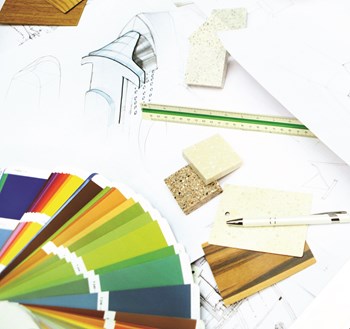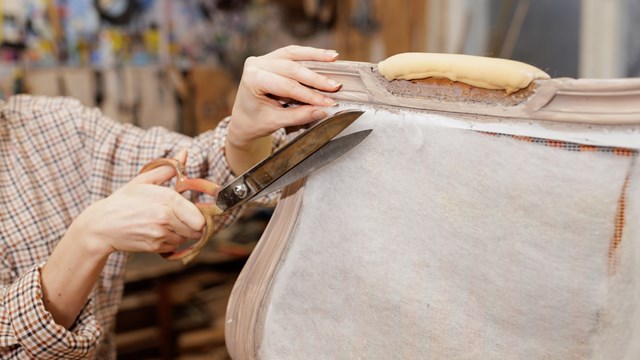
We've all done it: walking along a quiet street in the evening, our eyes are drawn to the lit windows overlooking the sidewalk-we crane our necks to catch a quick glimpse of the sumptuously-decorated apartment behind the curtains, and immediately begin speculating on how much it's all worth.
New York has always been an epicenter for high-end everything: fashion, culture, cuisine, architecture… and interior design. Manhattan's lavish apartments are legendary, and according to a recent edition of New York magazine, their owners have been known to shell out nearly $10,000 for a set of custom cabinets, $35 for a single glass drawer pull, or $5,500 for an antique bathtub without thinking twice.
"New Yorkers want and expect the best," says Rhona Cangelosi of Manhattan's Hastings Tile & Bath, "and there's probably not a better place in the country to find exactly what people are looking for. This city has everything. We can give our clientele that something extra that will satisfy-usually-even the toughest customer."
To Have, and to Sell
While some may content themselves with middle-of-the-road fixtures and finishes and concentrate their funds on a deluxe leather couch or top-of-the-line entertainment center, others want top-shelf design from the wall studs outward. One source of materials for these kinds of clients is the Architects and Designers Building, a 70,000-square-foot luxury home design bazaar on Manhattan's Upper East Side with 22 showrooms featuring everything from wall treatments to flooring, tiles to fixtures and cabinetry.
"The building is part of the Luxe Homes company, which specializes in high-end products that go into home buildings and renovations," says spokesperson Kate Flaherty. "What we have here are the top brands for all kitchen and bathrooms. If you are looking to redo your bathroom, we have some beautiful stone tile and plumbing showrooms-and others that just sell kitchen cabinetry."
According to Colette Whitney, an interior designer and decorator specializing in kitchens and baths and the president of Whitney Interiors, Ltd. in Manhattan, bathroom and kitchen design has rocketed from basic tile-and-sink choices to materials and designs every bit as luxurious and thought-out as what goes into a living room or bedroom.
The cost has rocketed, as well, however. According to Whitney, like a lot of things, installing or overhauling a kitchen or bath in Manhattan is more costly than it is just about anywhere else. In fact, it's nearly impossible to install a quality galley kitchen for under $50,000. "That's the base," says Whitney, "and that's using middle-of-the-road cabinetry and standard appliances. The price range for a high-end kitchen job," which would include cabinetry and appliances from such upscale manufacturers as Sub-Zero and Thermador, "will cost between $80,000 and $120,000." And that's just for a 7-by-14 foot long galley kitchen, a Manhattan staple.
Expense aside, says Flaherty, "It's an exciting time to renovate your kitchen or bathroom because the products on the market are some of the most exciting that have ever been seen."
With kitchens, some of those high-end products include state-of-the-art "intelligent" appliances, custom-crafted cabinets in exotic woods, and ornate glass tiles. According to Flaherty, investing in luxury materials and fixtures goes beyond mere aesthetics or conversation pieces.
"Clients are interested in purchasing a name-brand kitchen or having unique tilework because these are permanent elements that will improve the resale value of their home."
The Perfect Sanctuary
While some New York City-dwellers are forced to contend with bathrooms roughly the size of a high school locker, others have the means to create opulent spaces reminiscent of spas or luxury hotels. For those able to foot the bill, the master bathroom can become a marble- or translucent glass-tiled sanctuary, complete with roomy steam showers, Jacuzzis, whirlpools, saunas, and enough room to host a small cocktail party, if the owners were so inclined.
According to Flaherty, one item in particular that has gained a great deal of popularity in recent years for both kitchens and baths is custom glass tile. Of course, tile is not new. But thanks to new advances in manufacturing and design, there are more elegant options on the market than ever before. Tiling has come a long way since the days of plain white ceramic-these days, glass tile can be made in colors ranging from transparent tangerine to cool, minty green. Another popular (if high-ticket) option is metallic glazed tile, which can be left with a satiny, matte finish or polished to a mirror shine.
"High-end porcelain tile and metallic glaze is very New York," says Debbie Sarter, who deals with tiles at Hastings. "A lot of homes in New York are older, and this gives them an updated look."
According to Rebecca Alston, of Rebecca Alston, Inc., a Manhattan interior/architectural design firm, "Glass tiles have great translucent look that's very popular right now. But they're more expensive than ceramic-depending on the pigment, they can range anywhere from $20 per square foot for plain white to $500 per square foot for gold," she says.
Sarter agrees. "We're also seeing a lot of glass mosaics," she says. "Most of the glass tile is strong, contemporary, sleeker and cleaner than old-school glass or ceramic tile."
At the end of the day, using top-shelf talent and materials for a bathroom remodel will run you into the high five figures, at least. "The contractor alone will cost you $20,000," says Whitney. "The only leeway you have is the materials. You add the price of materials to the price of the contractor. And you can't do the materials for a bathroom for less than $10,000." Most renovators, she points out, opt for high-end materials-faucets, tiles, tubs, sinks, cabinets and lighting-that pushes the cost into the $40,000 to $50,000 range.
Style, Wall-to-Wall and Underfoot
Along with tiles and woodwork, another aspect of luxury home design getting a lot of attention lately is flooring. Satiny-smooth hardwood has been the gold standard for New York apartment flooring for years-and shows no sign of falling out of fashion any time soon-but a new array of materials and treatments are available today that have many remodelers and their design consultants looking past the obvious. Cork, bamboo, black slate, and even leather all make excellent flooring, say the designers, and if a client is looking for something new and unusual-and is willing to pay a premium for it-nothing is out of the question.
While the use of bamboo or even cork for floorboards might not seem like such a stretch, the idea and expense of using leather on one's floors usually raises an eyebrow. For those who know, however, leather is the newest and most desirable of materials. It's luxurious to the eye, warm and supple on the feet, and wears like iron. As you might guess, it doesn't come cheaply-leather flooring can cost more than top-tier hardwood, and requires a certain amount of extra care to retain its rich luster. Cow- and steerhide can be dyed any color an owner's heart desires, and can be used as a unique wall covering as well.
And speaking of walls-the definition of luxury has shifted somewhat in recent years from the over-the-top opulence of ornate wallpapers and voluminous drapes to looks that are more clean-cut and natural, if not downright spartan. Where once shareholder/owners were shelling out for $500-a-roll imported silk wallpaper, they're now considering materials like jute, sea grass, coir, cork, hemp, sisal, and dyed cotton fibers, according to Robert Raymond of Brunschwig & Fils, Inc. an interior design firm based in White Plains. The new wall treatments are beautiful, hard-wearing, versatile, and more in keeping with the simplified, no-fuss lifestyle many harried homeowners try to cultivate in their private spaces.
Extravagant Extras
Of course, some apartment owners opt to forego the dust and upheaval of re-flooring or tiling and create their own extravagant sanctuary by adding custom furniture and lighting, or by investing in a state-of-the-art audiovisual system.
Steve Joslyn of Smyrna, New York-based Joslyn Fine Metal Work has been creating custom-wrought metal furniture and lighting fixtures (using steel, primarily) for New Yorkers for the past 15 years, and believes that creating a space that fits its owner is more important than sheer material value.
"One of the great advantages of a having a custom piece made," says Joslyn, "is that you can do whatever you want. I like to get a feel for what their likes are and personalize it. I think just about everyone would like to make a personal statement in their living space."
For some apartment owners, those statements can also be made about sound and vision-when the idea of high-end, high-concept design is expanded to include multi-media and audiovisual equipment as well as décor and furnishings. And these days, you can forget about the towering stacks of black-and-silver stereo, video, and amplification components that used to dominate whole corners of apartments. Today, components are not only sleeker, but smarter as well-so smart, in fact, that for a premium, you can have your lighting, heat, and security wired together into one seamlessly functional system.
"We can provide control systems where everything is done in one organized place," says Scott Jordan, a system consultant of Electronics Design Group, Ltd. in Piscataway, New Jersey, a company specializing in state-of-the-art, custom-built audiovisual and electronics systems. "If you think about any home or apartment, all of the subsystems that you have in it-lighting, heating, shading, drapery, music, video, television-now you can bring all those things together onto one platform and be able to control all of them very easily."
"You can have a central audio/visual rack that feeds speakers throughout the apartment, and every single zone can have its own volume levels, as well as it's own discrete source," Jordan says. "Someone can have FM radio in the kitchen. Another person could be listening to a CD in the bedroom, while another could have a CD drive in bathroom. You can group up to 16 zones, all available on touch panels."
Over at Manhattan's New Heritage Building, there is a 6,000-square-foot apartment being fitted for 14 zones of heating and cooling that will take about six months to complete.
"The client wants the ability to control every single room from a single point instead of going room to room to adjusts thermostats," Jordan says. "When you go to bed, you can set the temperatures to a 'sleep mode,' all at the touch of your fingertips."
This is also important in controlling light. The same luxury-goods consumers who are interested in paving their bathrooms with Carrera marble and controlling their audiovisual systems from afar may also have lavish artwork that needs to be lit properly and protected from fading. By installing a custom panel that controls the apartment's light and window shades, they can create the perfect atmosphere for paintings, sculpture, and other works in their collection.
The Luxe Life
For those of us on more modest budgets, the options available at the upper end of the interior design and furnishing spectrum may seem outlandishly extravagant, but the motivations behind them and the aesthetic they represent are universal-and the effect trickles down. Not so long ago, high-end design was the jurisdiction of specialty stores and exclusive boutiques: today, anybody can buy home furnishings designed by Philippe Starck at Target, or inexpensive, high-concept furniture at IKEA. Even without millions in the bank, the desire to make our living spaces beautiful-for both ourselves and the passers-by on the evening sidewalk-is a natural human urge.
"I think people naturally look for something unique that represents their taste and speaks to them personally," says Joslyn. "That's why people seek out craftsman, cabinet-makers, or anyone in this one-of-a-kind or limited edition trade. They want to make that statement."






Leave a Comment